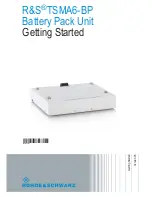
Excess temperature protection
The charger can be set to automatically stop the charging/discharge cycle when the battery
exceeds a preset temperature.
To use this function, an external temperature sensor must be fitted (not included).
This must be connected to the temperature sensor connection R or L (13, 14) on the
charger.
Trickle charging current (NiMH and NiCd batteries only)
Set the trickle charging current here. If a NiMH or NiCd battery is fully charged, it loses part of
its capacity again through self-discharge.
The trickle charging current (short charging pulses rather than a continuous charging current)
ensures that the battery remains fully charged. This also prevents crystal formation in the
battery.
Delay time for delta U detection (NiMH and NiCd batteries only)
The charger ends the charging cycle for NiMH and NiCd batteries using the delta U method.
Here, set how long the charger should continue charging after the delta U detection.
Voltage for delta U detection (NiMH batteries only)
Here, set the voltage at which the delta U charging method detects a fully charged battery. If
the value is too high, the charger may fail to recognise that the battery is fully charged. In that
case, the charging duration safety circuit will usually respond or maximum capacity will be
reached (if set correctly).
If the value is too low, the charger switches off before the battery is fully charged.
Change the voltage step-by-step and monitor the charging process. Due to the large
variety of different batteries, it is not possible to recommend an optimal setting.
Saving settings
To save the set values, select the ‘SAVE PROGRAM’ setting function, then briefly press the
ENTER button (3) and (20). Otherwise, all settings will be lost.
The charger displays a message (‘SAVE....COMPLETE’) and beeps to indicate that the settings
have been saved (if activated).
Loading battery profile data from the memory ‘BATT MEMORY’
• In the charger’s main menu, use the buttons (4) and (21) and STATUS - buttons
(5) and (18) to select the ‘BATT MEMORY’ function. The memory number flashes on the
display.
• Use the and STATUS - buttons to select one of the 10 memories. If the memory
already contains data, the bottom row of the display shows the battery type and number
of cells as well the charging and discharging current in succession. If the memory slot is
empty, ‘ENTER SET’ is displayed in the bottom row.
• Load the battery data for the charging profile from the selected memory by holding down
the ENTER button for more than 3 seconds. The message ‘ENTER CHARGE LOAD.....’
(7) and (8) appears on the LC display, the data are then loaded and the desired battery
programme can be started
• Press and hold the ENTER button for more than 3 seconds.
If you press and hold the ENTER button for more than 3 seconds when the
memory is empty, the charger starts selection/setting mode in which you can set
and save battery programmes.
LiPo battery measurement function ‘LI BATT METER’
The charger can display the current voltages of the cells in a lithium battery. With the LiPo
battery measurement function, you can display the highest voltage, the lowest voltage and the
voltage of each cell.
Make sure to connect the balancer connections to use the function.
To activate the display, proceed as follows:
Enter
In the charger’s main menu, use the (4) and
(21) and STATUS - buttons (5) and (18) to select the
battery measurement function ‘LI BATT METER’.
Confirm the selection with the ENTER button (3) and
(20). The voltage is then displayed.
The following values are shown on the LC display (7)
and (8).
- Individual voltages of the cells 1 - 6
- Total voltage (‘MAIN’), maximum cell voltage (‘H’) and
minimum cell voltage (‘L’).
System settings
The system settings of the charger summarise various basic settings. In the as-delivered
condition, these are preset with the most common values. When the battery is connected to the
power supply (11 - 18 V/DC) for the first time, the charger is operated with the preset default
settings.
You may need to change the values depending on the battery that you wish to charge/
discharge. The following information is displayed on the LC display (7) and (8) in sequence.
Individual parameters can be modified.
Proceed as follows:
PROGRAM SELECT
SYSTEM SE
Rest Time
CHG
>
DCHG 10Mi
SAFETY TIME
ON 120Mi
Capacity Cut-Off
ON 5000mAH
Key Beep
ON
Buzzer
ON
Input Power Low
Cut-Off 11.0V
Ext. Temp 0C
Int. Temp 37C
• Select the system setting ‘SYSTEM SET’ in the main menu.
• The ‘REST TIME’ setting appears first.
• Press the buttons (4) and (21) and STATUS - buttons (5) and (18) to switch
between the setting variables.
• If you want to modify a setting, press the ENTER button (3) and (20). The setting is
activated. The activated setting flashes.
• Press the and STATUS - buttons to modify the current setting.
• Press the ENTER buttons (3) and (20) to save a modified setting.
• Repeat this procedure for all adjustable parameters in the menu.
The setting variables are as follows:
Pause duration between charging/discharging ‘Rest Time’
A battery heats up during charging (depending on the charging current). In charging/
discharging cyclical operation, the charger can pause between charging and discharging to
allow the battery to cool down before the discharging process. Enter the duration of the pause
between charging and discharging to give the battery sufficient time to cool down before the
next process is started. The setting value for this time duration is from 1 to 60 minutes.
Safety timer
To prevent a faulty battery from being overcharged, you can set a max. charging time (safety
duration) which must not be exceeded during charging. As soon as a charging process starts,
the internal safety timer starts as well. If the charger cannot detect whether the battery is fully
charged for whatever reason (e.g. with delta U detection), the charging process is terminated
automatically after a set time if the safety timer is activated. This protects the battery from
overcharging.
The safety timer can be switched on or off. You can also modify the time the safety timer.
Do not select a time that is too short, otherwise the battery will not charge fully
before the time has elapsed.
Determining the safety duration for NiMH and NiCd batteries
Calculate the time for the safety timer as in the following examples:
Divide the battery capacity value by the charging current and then by a factor of 11.9.
battery capacity / charging current / 11.9
Factor 11.9 is used to ensure that the battery can be charged to 140% capacity
before the preset time elapses (i.e. guarantee that the battery will be fully charged).
Examples
Battery capacity
Charging current
Safety time
2000 mAh
2.0 A
2000/2.0=1000)/11.9 = 84 minutes
3300 mAh
3.0 A
3300/3.0=1100)/11.9 = 92 minutes
1000 mAh
1.2 A
1000/1.2=833)/11.9 = 70 minutes
Capacity limitation with automatic shut-off at maximum charging capacity ‘Capacity
Cut-Off’
This safety function determines the maximum capacity that can be supplied to the battery
during the charging process. The charging process is automatically ended when a certain
battery capacity is reached. If the deltapack voltage is not detected or the safety time has
elapsed, this function stops the charging process as soon as the set capacity value is reached
This safety function can be switched on or off. You can also configure the capacity.
Do not select a capacity that is too low, otherwise the battery will not be fully charged.
Switching button confirmation/warning tones on/off ‘Key Beep’
Use the ‘Key Beep’ function to enable (‘ON’) or disable (‘OFF’) button confirmation tones to
confirm operations and settings. Use the ‘Buzzer’ function to enable (‘ON’) or disable (‘OFF’)
function/warning messages.


































